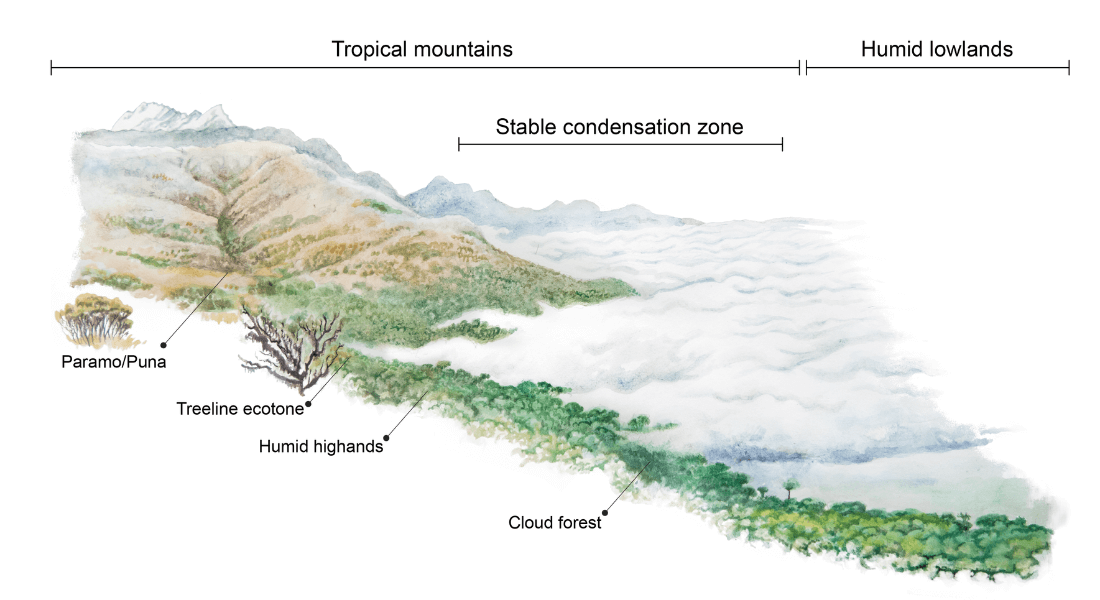Biodiversity cradles and museums: New study on speciation-extinction dynamics
The distribution of old and young species brings new insight into the speciation-extinction dynamics operating in global hotspots of biodiversity.

The immense concentrations of species in tropical mountains remain an enigma for understanding life’s distribution on Earth. A long-standing hypothesis suggests that montane biodiversity hotspots form within ecologically stable localities that concentrate young and old species with small geographic distributions (endemic species). Previous studies show that tropical mountains are hotspots for young and old endemic species, but how these species distribute between local valleys and along elevational gradients remains poorly supported.
Finding challenges long-standing hypothesis
A new study on Andean hummingbirds done by researchers at The Villum Center for Global Mountain Biodiversity at Globe Institute, shows that old and young endemic species are spatially segregated, not aggregated as the hypothesis describes. The young endemic species were scattered along the narrow Andean treeline (~3000 meters), whereas the old endemic species concentrated in the cloud forest zone at mid-elevation.
The work is published in Proceedings of the Royal Society B done by Jesper Sonne as first author and Carsten Rahbek as senior author with Bo Dalsgaard, Michael K. Borregaard, Jonathan Kennedy, and Jon Fjeldså as co-authors, all at the time of research at Center for Macroecology, Evolution and Climate (CMEC).
“This finding challenges our general understanding of the processes shaping biological hotspots. The fact that young and old species segregate could suggest that speciation and extinction processes operate in adjacent but distinct environments”, says postdoc Jesper Sonne.
Ingredients for building biodiversity hotspots
The treeline zone comprises a small, fragmented surface area that increases the chance for population fragmentation and, eventually, speciation. The overall dynamic environment characterizing the treeline zone is probably unsuited for maintaining old endemic species. By contrast, the cloud forest at lower elevations has a stable condensation zone and covers a broad range of elevations, and thus may have retained high connectivity during the Quaternary.

Elevational zonation of tropical mountain habitats, represented by the East Andes. The narrow treeline zone with patchy vegetation promotes speciation at high altitudes resulting in a scattered distribution of young endemic species. The habitats' width and connectivity increase towards the cloud forest at mid-elevation providing more optimal conditions (i.e. low extinction) for the persistence of old endemic species. Illustration by co-author Jon Fjeldså.
The unique ecological conditions combined with habitat connectivity could make the cloud forest ideal for preserving old endemic species, explains Professor Carsten Rahbek:
"These findings suggest that ecological stability and instability in adjacent geographical environments are ingredients for building global hotspots of biodiversity. It also explains why global biodiversity hotspots are often found in mountain regions and why mountain regions are extraordinarily species-rich compared with adjacent lowlands."
Info
Sonne, J., Dalsgaard, B., Borregaard, M.K., Kennedy, J., Fjeldså, J., and Rahbek, C. (2022). Biodiversity cradles and museums segregating within hotspots of endemism. Proc. R. Soc. B 289: 20221102. Download paper.
Contact
Postdoc Jesper Sonne
Professor Carsten Rahbek
